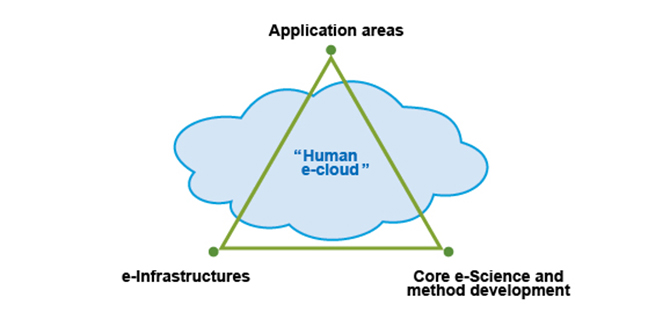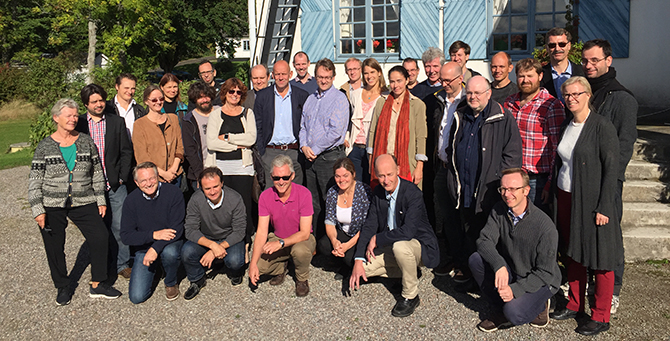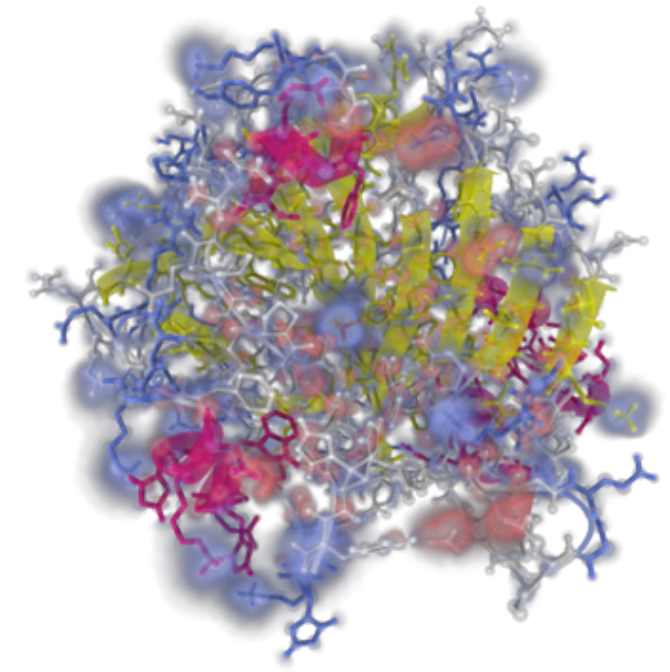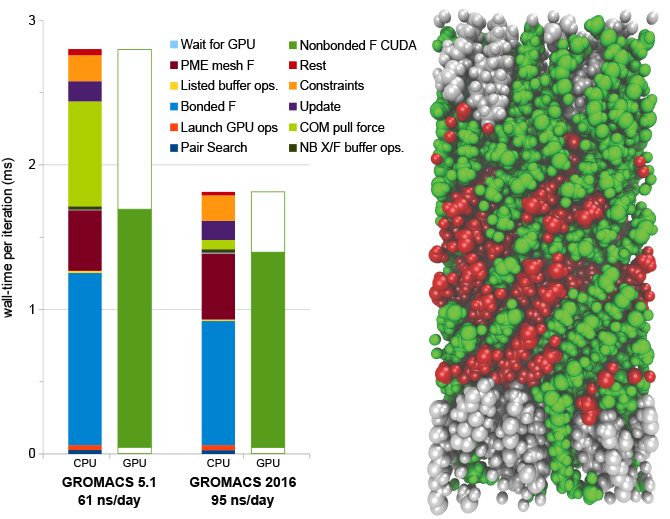SeRC: The First Five Years and Future Plans
Olivia Eriksson, Erwin Laure, Erik Lindahl, Dan Henningson and Anders Ynnerman, SeRC
What is SeRC?
The Swedish e-Science Research Centre (SeRC) is a scientific environment within the strategic research area (SRA) of e-Science, and is funded by the Swedish Government. SeRC is based on a collaboration between four Swedish universities: the KTH Royal Institute of Technology (KTH), Stockholm University (SU), the Karolinska Institute (KI) and Linköping University (LiU). SeRC's mission statement is to develop state-of-the-art e-Science tools and provide e-infrastructure support to existing and emerging e-Science research communities to help bring about scientific breakthroughs in Sweden.
SeRC was founded in 2010 as the result of the SRA initiative launched by the Swedish Government Bill on Research Policy in 2008, where a total of 24 different strategic research areas were defined – one of which was e-Science. Initially SeRC was granted funding for five years. During those first five years, SeRC has built an organisation for e-Science research, which has been highly successful – this was reflected in the excellent grades that SeRC received when the SRAs in Sweden were evaluated in 2015. The next phase of SeRC will partly focus on activities relating to emerging technologies (such as exascale and big data) while also consolidating SeRC’s ongoing efforts in working towards a long-lasting e-Science environment in Sweden.
e-Science and SeRC
We are right in the middle of a revolution where computers are redefining the process of scientific research as we know it. While this trend started in the natural and engineering sciences, it has evolved to become a pervasive component of virtually all scientific fields: modern aeroplane design depends more on computational fluid dynamics than on wind tunnels, bioinformatics has turned biology into a quantitative subject, and we are seeing entirely new data-driven research, for instance in medicine.
Many of the challenges that are being faced in this new e-Science are similar across different scientific disciplines: all these research directions rely on having access to large computational resources and the ability to work with and archive huge amounts of data, and they also need new algorithms (for performing both computations and large-scale analysis of data). Consequently there is also a demand now for new types of e-Science experts, known as application experts, who are highly skilled in a particular applied research area and also in e-infrastructures or method development.
The concept of e-Science is, in its most basic form, simply the notion of using digital information and processing that information to gain new scientific insights. This means that a lot of e-Science research can be conducted using the standard hardware and software that is widely available. However there are also research problems that require additional resources, which is where SeRC comes in.
SeRC’s Scope, Model and Mission
SeRC's scope is to address the e-Science problems that need solutions which go beyond the standard ones that are currently available, and that require researchers to have access to a state-of-the-art e-infrastructure as well as new e-Science methodology and technology. SeRC is thereby pushing the development of new e-Science tools forward. In this way SeRC paves the path for new high-end e-Science that will eventually mature and benefit not only the groups involved in SeRC, but also the whole academic base of e-Science users.
To address these kinds of problems, SeRC is based on a three-pillar model (shown below) in which existing excellence in application areas, core e-Science and method development, and computational infrastructures interact to find new e-Science solutions. In particular, this is done through collaborations and application experts active in at least two of these pillar areas. For the long-term, SeRC is working on developing a “human e-cloud” in order to better address challenges that are common to different application areas, and also to provide clear career paths for this new kind of researcher with dual expertise (that is, the application experts).

Pillar 1: Application Areas
One of SeRC’s central goals is to have direct impact in application areas of strategic relevance for our partner universities, and we also want to focus on research topics where SeRC has world-leading research groups. These SeRC application areas include fields such as computational fluid dynamics, materials science, bioinformatics, cancer epidemiology and screening, neuroinformatics, molecular simulation, and climate modelling.
Pillar 2: e-Infrastructures
SeRC wants to facilitate the development of a world-class computational infrastructure at PDC, at the National Supercomputer Centre at Linköping University, and at the visualisation centres affiliated with SeRC (which are based in Norrköping and at KTH in Stockholm). The development of this infrastructure includes competitive hardware investments in collaboration with the Swedish National Infrastructure for Computing (SNIC), although it is equally important to recruit advanced infrastructure experts to develop key simulation codes further.
Pillar 3: Core e-Science and Method Development
An integral part of SeRC is leading-edge research in core e-Science and method development, for instance in fields such as numerical analysis, visualisation, parallelization, acceleration, and data engineering. SeRC has several core research groups that provide both the latest research results for e-Science tools as well as a broad competence base in e-Science tool usage and methodology.
“The Human e-Cloud”
For SeRC, the central challenge is to get these three pillars to strengthen and support each other through collaborations. Infrastructures and core e-Science do not exist in a vacuum, but need to engage directly in research on important applications. In particular SeRC focuses on supporting application areas where we see an opportunity to translate advances in fundamental e-Science into research impact.
Our primary tool to achieve this is the recruitment of cross-disciplinary e-Science experts (application experts) that work between these areas – we call them the “human e-cloud” in the figure on the previous page. These experts combine a deep knowledge of an application area with expertise either in method development or large-scale computational infrastructures. By integrating the application experts into the applied research environments (while they work close to the method development groups or the infrastructure), it provides opportunities for close collaborations between application experts and applied researchers, as well as between application experts facing similar challenges (for instance in parallelization, data management or method development) in different application areas.
Organisation
SeRC consists of ten research communities, within which the e-Science research takes place, together with the SeRC e-Science infrastructure. Some of the SeRC research communities focus on core e-Science methodology, like numerical analysis, parallel software and data engineering and visualization, whereas others focus on applying the methodology in a particular area, like bioinformatics, neuroinformatics, cancer epidemiology and screening, molecular simulation, electronic structure, computational fluid dynamics or climate research. The infrastructure on the other hand consists of:
- two supercomputer centres – the PDC Center for High Performance Computing at KTH (PDC) and the National Supercomputing Centre at LiU (NSC), both of which are part of SNIC,
- two visualisation centres – the Visualization Center C (VC), located in Norrköping, and the Visualisation Studio at KTH (VIC), and
- a number of application experts who are employed at the supercomputer centres, and who work closely with the research communities.
SeRC co-finances about 30 projects and 15 faculty positions, including a number of larger Multidisciplinary Collaboration Programmes that were initiated in order to increase the level of collaboration between researchers in the areas of applications, methodology and infrastructure.
In December 2013, to consolidate the organisation, SeRC was turned into a research centre with KTH as the host, and we recruited an external chair of the board, Professor Morten Dæhlen, who is Dean of Mathematics and Natural Sciences at the University of Oslo and a prominent international e-Science leader. More information about the SeRC organisation can be found at www.e-science.se/org .
SeRC Faculty
Since the inception of SeRC, we have recruited a substantial number of highly skilled assistant professors. In addition, we have selected a number of e-Science investigators who were either hired recently or who recently joined SeRC with support from other funding. Together, these researchers form the SeRC faculty.

The main goal of the SeRC faculty is to facilitate interdisciplinary exchange between e-Science communities in application areas and core e-Science and method development, and to provide SeRC with a network of e-Science researchers that straddle the various research communities.
Collaborations and Scientific Output
SeRC hosts a large number of outstanding scientists who are pushing the state-of-the-art, in application areas as well as method development, with several high-impact results. However, SeRC’s mission is to go a step beyond merely providing some marginal funding and instead build a scientific environment that promotes excellence within research disciplines through multi-disciplinary collaboration. SeRC makes it possible to initiate new, ambitious, and risky collaborative projects that have the potential to redefine research fields. In particular, the centre has acted as a catalyst in the formation of several strong research environments that work on the application, method-development, and infrastructure aspects of computational research (for example, see the figure to the right). These multidisciplinary collaborative projects for instance make it possible to engage computational experts in long-term development efforts that had previously been very difficult to fund.

The new initiatives have had tremendous scientific impact: one of the SeRC software projects produced what became Sweden’s single most cited scientific paper during 2014, teams that did not even know each other prior to SeRC have merged, and the collaborations between infrastructures and researchers have led to a range of new high-profile international research projects being funded, not to mention the award of several prestigious European Research Council grants. The publication output by SeRC research projects has almost doubled from 2010 to 2014, and the publications of the SeRC researchers have an average field-normalized citation rate, which is a measure of scientific impact, of 1.92 for the period 2010-2014, which is almost two times the world average.
However, instead of being content with these achievements, SeRC will keep raising the bar by continuously evaluating our collaborations with a view to further improving the centre’s effectiveness. SeRC’s goal is not to maintain the status quo, but to promote discoveries and new applications by helping and encouraging talented researchers to team up and leave their comfort zone. Collaboration, multidisciplinarity, change, and impact are the genes of SeRC.
Computing Resources
e-Science is critically dependent on efficient large-scale computing and storage resources. Within SeRC, these resources are provided by the leading Swedish high performance computing centres, PDC and NSC, which offer more than two thirds of the Swedish national compute capacity. A strategic partnership between these centres has been established. This allows for better coordination and alignment of their services with the needs of SeRC researchers.
Since 2015, SeRC researchers have had access to petascale computing resources (see below) through these centres. But it is noteworthy that PDC and NSC not only provide hardware, they also provide expertise in many application areas in terms of computing experts who work closely with certain scientific domains, including bioinformatics, climate research, computational fluid dynamics, materials sciences, molecular dynamics, and neuroinformatics.
The Future and e-Science Agenda
During its first five years, SeRC has had tremendous success in establishing e-Science in Sweden and fostering the e-Science paradigm in many research areas. e-Science is now well established and is a priority area at the SeRC partner universities. The next phase of SeRC (2015–2019) will, on the one hand, further consolidate these efforts by working towards a long-lasting e-Science environment, and, on the other hand, increase SeRC activities relating to emerging technologies, such as exascale and big data.
The recent report Swedish Science Cases for e-Infrastructure is an important document when it comes to shaping the future of e-Science in Sweden. This document discusses strategic e-Science development in Sweden and makes a number of recommendations that will help to guide future SeRC developments. Key findings, from a SeRC perspective, include the following.
- “Development of methods, tools and software within core disciplines is necessary to make breakthroughs.”
- “Advanced and long-term user support and human infrastructures are keys to e-Science adoption.”
- “The simulation paradigm dominates the current Swedish needs for e-infrastructure. A complementary and more data-centric aspect of e-Science should be promoted.”
- “e-Social science and e-humanities are potentially very large users, but need active support, like other research communities new to e-Science.”
- “e-Science methods and tools are in increasing demand and will be instrumental in increasing interaction between tool makers and tool users.”
Responding to these findings entails work at several levels ranging from infrastructure and tool development to policy definitions. In its strategy process, SeRC has defined an agenda for the next five years. This agenda addresses many of the items from the report and describes how SeRC is in a unique position to spearhead this work.
Later sections give an overview of the new SeRC initiatives that have been defined to help SeRC evolve as an organisation, and to pave the way for the next stage of e-Science development and deployment in Sweden.
The Impact of e-Science
The impact of e-Science can be seen in all areas of academia. The use of basic e-Science in new domains can generate fundamentally new and important results. At the same time, access to advanced e-Science tools and infrastructures enables the leading research groups that are spear-heading Swedish e-Science to compete at the international forefront.
In view of this, SeRC intends to intensify the collaboration with relevant Swedish groups and universities that are currently not part of SeRC and aims for a national scope in domains like bioinformatics, numerical analysis and materials science. By expanding such collaborations, SeRC will develop into a truly national organisation. This will also allow SeRC to take responsibility for further developing the Swedish e-infrastructure landscape together with SNIC.
The impact of the broad adoption of e-Science methodology cannot be overestimated. Through extensive collaborations with industry and governmental agencies, SeRC has a direct impact in society and contributes to societal development and commercial competitiveness. SeRC has several industrial representatives on its advisory board, and we are delighted with their interest and engagement in learning how computing can change what they do, for instance at our annual meetings. One of the primary indirect mechanisms for SeRC to have an effect is through knowledge transfer in the form of recent Ph.D. graduates, who have unique experiences of e-Science and form a network consisting of the next generation of e-scientists.
The single largest overall success of SeRC is that it has helped application researchers and computational experts to find each other and speak with one voice. Large-scale data analysis and simulation have been introduced in areas where they have never been used before, the strongest computational groups in the country suddenly collaborate internationally instead of competing nationally, and we will keep redefining these boundaries by identifying areas where the combination of computational and application research excellence makes a field ripe for disruptive changes to the science.
SeRC Initiative: Multidisciplinary Collaboration Programmes
In the first phase of SeRC, larger, multidisciplinary constellations have been prototyped through a multidisciplinary collaboration programme (MCP) promoting multidisciplinary approaches to strategic research areas with high potential for gains. The e-Science for Cancer Prevention and Control (eCPC) was SeRC’s first MCP, which was followed by Visualisation In e-Science Applications (see above) and SESSI - SeRC Exascale Simulation Software Initiative (see below). SeRC will now build on these successes and further develop the MCPs by consolidating the SeRC efforts into larger constellations.
A key requirement of MCPs is the existence of external third-party support contributing to the programme goals. These multiple funding streams are one component to ensure the sustainability of SeRC efforts. For 2015–2019, three additional MCPs have been started: Data-Driven Computational Materials Design, FAST Climate Science and Brain-IT.
SeRC Initiative: Scientific Computing Lab
SeRC groups are engaged in the development of computational methods and infrastructures, which are necessary ingredients for world-class computer-based science research. With architectural changes, which are being driven partly by the challenge of building exascale systems, these efforts need to be reinforced and strengthened. Developments – such as massively increased core-counts, large vector units, deep memory hierarchies, and the like – require significant efforts in the development of efficient, scalable methods and implementations.
Such work is planned in the multidisciplinary collaboration programs referred to earlier. These constitute ideal cases for the SeRC vision of integrating researchers (from the three pillars that were described earlier) with each other in such a way that collaboration between application area, e-infrastructure and methods researchers is being facilitated by the application experts in the Human e-Cloud.
Following international examples, for instance from the National Center for Supercomputing Applications at the University of Illinois at Urbana-Champaign, we intend to prototype a scientific computing lab, where researchers working on applications, methods, and infrastructure can effectively collaborate in such a manner. A physical interaction space that will be created at PDC is a key component in this endeavour. With this lab, SeRC will build the nucleus of the Human e-Cloud identified as a key ingredient above.
SeRC Initiative: Data-driven Science
The data deluge that is arising from new scientific instruments, large simulations, and data on the internet, together with new technologies for handling and analysing this data, has significant impact on e-Science methodology. SeRC is therefore embracing big data, with an initial emphasis on the life sciences. This includes research regarding storage, management, integration, visualisation, and analysis of big data.
In recent years, new platforms and tools have appeared that can efficiently and cost-effectively store and process up to petabytes of data. This allows many organisations to handle data that was previously considered to be too expensive to store and manage. This data-driven science trend is transforming scientific research, by making data-driven discovery and prediction possible. The requirements for data analytics on a large scale include data management on public and private clouds, data-parallel algorithms, and proficiency with a complex ecosystem of tools and platforms such as Hadoop. Currently these are not widely available within the existing SeRC research communities, so one of the goals for SeRC is to help transfer knowledge about the use of methods and tools from data science to facilitate the use of new research methodologies in other SeRC communities.

